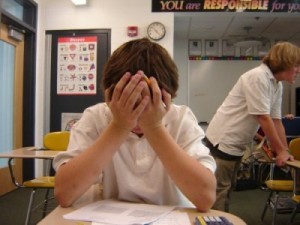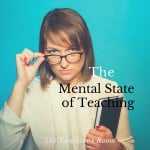By Guest Writer Jessica Classen
 “But I’ve passed all my classes! I mean, I should be able to graduate. Will I have to go summer school? Will I not be able to walk? What happens?” The panic in his voice was clear. Adam, a bright, hard-working junior, was already terrified of the possibility of failing a test months away.
“But I’ve passed all my classes! I mean, I should be able to graduate. Will I have to go summer school? Will I not be able to walk? What happens?” The panic in his voice was clear. Adam, a bright, hard-working junior, was already terrified of the possibility of failing a test months away.
In my calmest teacher voice, I assured Adam, and those sitting around him whose faces indicated their shared fear, that this particular score was not the be all and end all, there were other paths, other options. “You can do work samples. You will graduate.”
“But if I don’t get work samples done in time?”
“It would mean summer school, but I don’t think it will come to that. You will graduate.” I repeated.
After my promises, he seemed pacified, but I couldn’t help but wonder if my words had been empty. At the end of the day, while what I said was true, it would not minimize the personal impact of failure. I was reminded of a scene from one of the many gloriously trashy TV shows I’d binged watched over the recent winter break in which a character callously refers to a room of dead innocents as collateral damage−poor schmucks who were in the wrong place at the wrong time. Those two words stuck in my head.
Collateral Damage.
In wartime, before ordering any military action, strategists must analyze all tactics for the possibility of inflicting collateral damage. The decision to take action often rests on whether or not any innocent lives will be taken. I wondered that if the designers of this test, the latest weapon in the war on education, had given thought to the collateral damage, the students, like mine, who would spend sleepless nights waiting for the bomb to drop come spring.
A Revelation
Wow. They know.
Earlier that day, I had polled my students, juniors who have the “honor” of being the first class to take the testing behemoth that is Smarter Balanced. In January, our district has students complete a test modeled after the writing portion of Smarter Balanced. This is done under the premise of tracking growth, but in reality, we all know that it serves a much more practical and cynical purpose: counting as possible work samples for those who will not pass. These assessments, like the Smarter Balanced, are not generated out of meaningful work in the classroom, but handed down from an outside source. Instead of authentic writing, this year my students will write an expository essay on geocaching, a hobby in which enthusiasts search for a hidden object using GPS coordinates. It is a topic I guarantee is a completely foreign concept to most students at my school, the largest urban, high-poverty school in the state.
As our time to take the district writing assessment drew near, my thoughts were preoccupied with all things testing. I wondered what my students already knew about the monstrosity coming their way, so I created a Google Form with six simple questions. I assured my students anonymity and encouraged them to simply be honest:
1. How much do you know about the Smarter Balanced Test coming this spring?
2. How prepared do you feel to take the Smarter Balanced test?
3. Do you know the test is tied to graduation?
4. Do you know what is required of you if you do not pass?
5. What specifically have you heard from either teachers or students about the Smarter Balanced test?
6. What questions do you have about the test?
The answers to the first four questions were not particularly surprising. The majority of students didn’t feel they knew much about the upcoming test and an even greater majority didn’t feel prepared. Most knew it was tied to graduation, but were not sure what was required if they didn’t pass. However, it was the responses to questions 5 and 6 that provided a revelation. Students wrote:
“Why are we supposed to take a test that 60-70% of my graduating class are projected to fail?”
“I have heard a lot of information about this test, most of the information being about how this so-called ‘better test’ is far from being finished, or about how when it is actually done, only 35% of the students that take it are expected to pass.”
“Projected 62% fail rate by experts”
“I’ve heard that this test is going to be harder than the OAKS test [fusion_builder_container hundred_percent=”yes” overflow=”visible”][fusion_builder_row][fusion_builder_column type=”1_1″ background_position=”left top” background_color=”” border_size=”” border_color=”” border_style=”solid” spacing=”yes” background_image=”” background_repeat=”no-repeat” padding=”” margin_top=”0px” margin_bottom=”0px” class=”” id=”” animation_type=”” animation_speed=”0.3″ animation_direction=”left” hide_on_mobile=”no” center_content=”no” min_height=”none”][the previous state test in Oregon]. Also, that they are expecting only 1 out of 3 students to pass this test.”
“Why would they hang our graduation on a test that has an expected 62% failure rate?”
These students knew that they were expected to fail.
The weight of this realization sunk in. I now knew what prompted Adam’s questioning. He, like many of my juniors, did not expect to be able to pass Smarter Balanced. They knew that the Smarter Balanced consortium, the creators of the assessment that could very well dictate their future, had projected that only 41% of students would pass ELA and a mere 33% would pass math. They were defeated before they could even begin.
Shared Panic
My students are not alone in their anxiety. Most teachers I know had their own moment of panic upon first seeing the projected statistics. This panic has not been assuaged by the release of practice tests by the Smarter Balanced Consortium. The past few weeks have seen a series of strained conversations among the members of my department who have attempted to take them.
My own PLT recently gave it a go. At 7:30 on a Wednesday morning, we sat, coffee in hand, ready for battle. I, for one, wondered how difficult it could really be. One-by-one the color drained from our faces as we read through the first pieces, articles that were apparently designed to teach the students that solar power was a pipe dream and fossil fuels are the best energy option, and their subsequent questions. They were hard, yes, but we expected that, what we didn’t expect was the complete and utter confusion.
“What’s the deal with number two?” I wondered aloud at the complicated two-part question in front of me. “Part B asks for the detail that supports the claim selected in Part A. So what if the student selects the wrong claim in A, but the correct detail for that particular claim. Do they not get credit for that skill because the initial claim was wrong?”
“What do you mean?”
“Well, it’s possible that a student would select ‘the government is attempting to support the use of solar energy’ as the central point of the piece, which I believe is the incorrect choice. If they do, then there are details in part B that support that particular claim. If a student can match detail to claim, that’s a skill, but if their initial claim, part A, isn’t right, then is that ability recognized, or is it all wrong?”
My colleagues shrugged and shook their heads. The siege continued, and soon more voices popped up.
“Hold on, what did you get for three under “Sustainable Fashion?” Which statement best summarizes the central idea of the text? It looks like it could be more than one of these sentences. Can there be two right answers?”
“You mean there are no answers for the practice test? How do students know if they got it right?”
“What’s up with seven? ‘How does the second paragraph affect the structure of the text as a whole?’ Is it referring to the second paragraph of the entire text or just the excerpt that was used to answer question six? It’s not clear at all.”
“Who wrote these questions????”
“Wait. Can they print the text??? Mark it at least???”
After an hour, six highly educated, experienced teachers found themselves staring at a computer with the mix of anger and defeat. We had been beaten by the difficult, vaguely worded questions and an awkward interface, and we all wondered the same thing. If we can’t work through it, how in the world can our students?
I imagine Adam sitting alone before the screen, frustrated. Confined by rules, he will not be able to commiserate with his classmates about the length of the test or the ambiguous questions. When the instructions don’t explicitly state which of the multiple texts on the screen he supposed to refer to for question 14, he won’t be able to ask for my help. I wonder if he will persevere, especially with the knowledge that the experts don’t expect him to do well anyway. Adam’s not a quitter, he successfully resurrected his grade after a nasty sports injury kept him out of my class for almost two months, but why try when you’ve been told your efforts are futile?
I cannot even imagine a scenario in which I would hand a student a test, tell him or her that he or she will very likely fail it and then expect the student’s best work. It’s absurd, and it’s cruel. Yet this is exactly what the consortium is doing, telling our students that they are failures before they even have a chance to try.
Low Expectations
My students are no strangers to low expectations. They live in an area of town locals refer to as “The Numbers.” When reporters write about this area of town, they use words like “relatively dangerous,” “uneducated,” “ignored.” I’ve been told I’m a saint for working with “those kinds” of students and asked if I feel safe at my job. The world in general doesn’t expect much from these kids. They fight bravely against these expectations every day.
Unlike local detractors, the consortium’s dismal projections are not personal. They aren’t based on location or SES. The problem is that it doesn’t feel any less personal to my students. The hurt and anger is there in my students’ survey responses:
“WHY ARE THEY KILLING US?!?!?!?!?!?!? No one wants this!”
“IT IS NOT FAIR AT ALL WHATSOEVER!”
“Why make it harder? Why set more kids to fail?”
I have been over and over this question in my mind. Why set more kids to fail? Why in the world would the powers that be adopt this test for this graduating class, one that has only begun to learn under Common Core? Why tie it to graduation? Why embrace an assessment that is designed to conquer and demoralize the majority of its young takers?
Rob Saxton, Oregon’s Chief of Schools, has publicly defended the choice, claiming that Smarter Balanced will force educators to identify and finally be honest with students who are simply not ready for college. Citing the number of students in college who require remedial classes, Saxton was quoted in The Oregonian in December as saying:
We need to be honest with what kinds of outcomes we are having with students and what that is going to mean for them in college or in the workplace. We have not taught to a high enough standard. I feel those scores are accurate. Before, we always sugarcoated it. Kids and parents thought they were on the trajectory for success and they weren’t because we were too afraid to be honest.
When looking at Mr. Saxon’s commitment to honesty, we must first consider his assumption that a test like Smarter Balanced will, in fact, actually predict college success. A recent study that analyzed the records of 123,000 alumni from 33 colleges and universities showed that high school GPA had a significantly stronger correlation to post-secondary success than scores on high stakes tests like the SAT and ACT. So telling a student that this test is an indicator of whether or not they can handle college is actually misleading, not honest, and while we are on the subject of honesty, how honest is it to link a test to graduation for students who spent the majority of their educational career under another set of standards? This year’s juniors have only begun to be taught curriculum that was developed according to Common Core standards. Most of their 11 years of schooling was dictated by state standards, which, like books by the same author, may have a similar ring, but are a different story altogether. I wouldn’t have my students read Of Mice and Men then fail them when they couldn’t pass a test on Grapes of Wrath. That wouldn’t be honest, would it?
Beyond that, this so called “honesty” comes with a major price. Our students are being told that they must accept and internalize failure. Mr. Saxton may see the failure as the system’s or even the teachers’, but students do not share that view. In the article, “How Testing Feeds the School to Prison Pipeline,” Fairtest.org points out that high stakes testing makes students feel like they are little more than a test score and push out those very students that we as educators are trying desperately to reach, contributing to higher dropout rates. After the implementation of NCLB, 73 of this country’s largest 100 school districts began to see declining graduation rates when prior, 68 of these same districts were seeing the opposite trend. So if high-stakes testing and exit exams correlate with dropping graduation rates, we must question the motive of this “honesty.” Is Smarter Balanced designed to play a part in preparing students for success, or is it here to simply push out those not deemed “worthy” of higher education?
Minimizing the Damage
After establishing a projection for collateral damage, military strategists then must decide whether or not to move forward, whether the possible lives lost are worth it. Unfortunately these same analysts will not likely look in the eyes of a mother after a stray bullet made her son collateral damage, just as Mr. Saxton here in Oregon and the consortium will not sit before my class and see the trembling hands, the sighs of frustration, the tears.
So now what? Well, as a teacher, I can try to shield them from stray bullets. I will sacrifice curriculum I believe in so that they can spend time becoming comfortable with the interface and understanding the nature of SBAC questions. I will give them opportunities to bank work samples. I will continue to help them develop writing and critical thinking skills. I will continue to encourage. I will continue to praise the wonderful things I see them do every day.
However, this will not be enough.
Students must be given the tools to defend themselves. They can’t sit passively and wait for the onslaught. Mr. Saxton is not wrong in the idea that we should be honest with students and parents, however, the honest truth is not that these students are failures. The truth is that deeply flawed, high stakes tests are by no means a measure of a student’s potential for success, and should not be seen as such. So on top of everything else, I will start an honest conversation, one in which the students can try to see these tests for what they are, because right now the knowledge that they are so very much more than a test score is the best defense I can give.
Jessica Classen has an M.A.T. from Concordia University and is endorsed in MS/HS Language Arts and as a reading specialist. She has been teaching various levels of Language Arts and Reading and Writing Intervention at the largest urban high school in Portland, Oregon for the past nine years.
[/fusion_builder_column][/fusion_builder_row][/fusion_builder_container]




